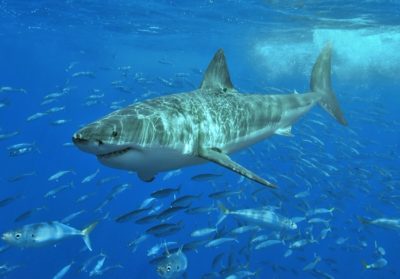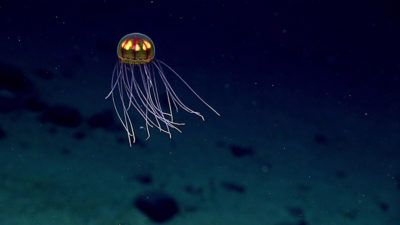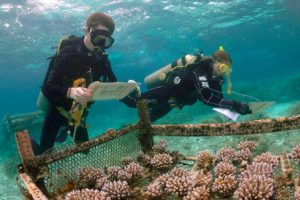Halfway between California and Hawaii is a pristine spot where, once a year, some 80 percent of northeastern Pacific great white sharks come to meet. No one knows why they congregate in this place, nicknamed the “White Shark Café” by the researchers who discovered it in the early 2000s. It is a unique and mysterious site, yet there is nothing to stop the international longline fleet from plying these waters.
The shark café is just one of many special sites in the open ocean with no formal mechanism of protection. They aren’t in any park, heritage site, or marine protected area. There is no single global mechanism to guard them, police them, or protect them. Stranded in the high seas — the two thirds of our oceans that fall outside of national ownership — they escape the usual rules of law. Like the old Wild West, this is the Wild Wet.
But just as international agreements have arisen to govern the “global commons” of our planet’s atmosphere and temperature, momentum is now growing to grapple with the common wealth of the sea. “There has been a ramping up of efforts,” says University of British Columbia economist Rashid Sumaila, who studies high seas fisheries. The United Nations is working up a new legally binding agreement on high seas biodiversity, for example, and an international Global Ocean Commission released its final report on protecting the high seas in February of this year.
Both of these efforts throw a spotlight on the need for high seas Marine Protected Areas (MPAs), which could cordon off fish nurseries or other important sites to commercial fishing and allow stocks to replenish.
MPAs in nationally controlled waters — a favorite tool of many (but not all) marine conservation advocates — can let crippled fish stocks recover and even boost commercial fisheries. “A lot of science has shown that MPAs, especially those that are fully protected, are key,” says KerriLynn Miller, officer for the Pew Charitable Trust’s Protecting Ocean Life on the High Seas campaign.
As part of the UN Convention on Biological Diversity, most governments are committed to designating at least 10 percent of their territorial waters as MPAs by 2020 (compared to less than 3 percent today). Others have suggested that a target of more than 30 percent is needed to keep the oceans thriving. But for now, there’s no clear way to create MPAs outside of nationally governed waters, which only extend about 200 miles out from the coast.
The UN and others are now working on mechanisms to create and protect marine reserves in international waters. If they succeed, open-ocean marine parks could become commonplace within a decade — an important step, advocates say, in slowing the sharp decline in marine biodiversity.
________
The problems out in the Wild Wet are many. Total catches of large, open-ocean fish like tuna have exploded, from 400,000 metric tons in 1950 to nearly 4 million tons in the 2000s. Globally, shark populations have declined by 70 to 80 percent. According to one estimate, more than half of highly migratory oceanic sharks and a third of tuna-like fish are now overexploited or depleted. New technologies are enabling oil, gas, and mineral extraction to move into ever-deeper waters, threatening ecosystems of bottom-dwelling corals, worms, and fish.
Back in the early days of ocean regulation, the main point was to make sure that everyone had fair and equal access to open waters: “Freedom of fishing” is literally written into the text of the 1958 UN Geneva Convention on the High Seas, which was more about preventing piracy than protecting ecology. The wording and intent of treaties, at least, has improved. The 1994 edition of the UN Convention on the Law of the Sea (UNCLOS) is guided by the principle of the high seas being the “common heritage of mankind.” It promotes conservation and preservation of the marine environment, has rules against over-exploitation, and led to the formation of the International Seabed Authority, for example, to help govern seafloor mining (although the United States never signed on to UNCLOS).
In 1995, a UN Fish Stocks Agreement also created a network of Regional Fisheries Management Organizations (RFMOs) to set quotas for migratory species like tuna. Today, more than a dozen high seas governance organizations are trying to keep things in line. “On paper it looks good,” says Sumaila. “The problem comes with implementation.”
RFMOs, for example, haven’t been too successful; as of 2010, at least two-thirds of stocks under RFMO management were depleted or overfished. And while organizations exist for regulating fishing, shipping, and mining, notes Miller, “those organizations aren’t coordinating in a coherent way. There’s no way to assess cumulative impacts.” Importantly, she says, UNCLOS provides no way to establish a no-take MPA in the high seas.
A few high-seas pockets have been made into MPAs. Starting in 2010, 10 marine protected areas, covering a total of 110,000 square miles, were established in the high seas of the northeast Atlantic Ocean, for example. But that is an anomaly — made possible by regional negotiations of the OSPAR Commission, a cooperative effort of 15 governments and the European Union to protect the northeast Atlantic. There’s no obvious way to do the same in all the other oceans of the world.
Progress toward a more general system for open-ocean MPAs has been slow, but is finally making headway. More than a decade after the UN General Assembly decided to pursue better high seas protections, the organization is now working on such an agreement, which could be decided on at a treaty conference in 2018 and implemented a few years later. One of the main objectives of the agreement would be to devise mechanisms for creating MPAs in the high seas, though the details of how those MPAs would be chosen, monitored, and enforced haven’t been worked out yet.
________
Where would open-ocean MPAs be established? The Convention of Biological Diversity last year highlighted more than 200 “Ecologically or Biologically Significant Marine Areas.” More than 60 of these are in the high seas, including the mysterious “White Shark Café”; the Sargasso Sea, home to the world’s only open-ocean algae; and the North Pacific Transition zone, a migration corridor across the middle of the Pacific for loggerhead sea turtles and bluefin tuna.
Last month, the UN’s World Heritage Convention nominated five of these spots as candidate Heritage Sites, another possible mechanism for protecting areas of interest in the high seas. In addition to the shark café and the Sargasso Sea, the World Heritage Center chose the Costa Rica Thermal Dome, a biodiversity hotspot in the tropical Pacific; the Lost City Hydrothermal Field, an area of delicate spires where hot water bubbles into the mid-Atlantic ocean; and the Atlantis Bank, a sunken island in the Indian Ocean.
“These are the no-brainers for protection,” says Fanny Douvere, coordinator of the World Heritage’s Marine Program.
Signatories to the World Heritage Convention would have to vote at some future meeting on whether, and how, they would like to make those sites official. All of the existing 47 marine-based Heritage Sites, including Belize’s Barrier Reef and the Florida Everglades, are within national boundaries.
Critics of the MPA approach counter that protecting isolated spots doesn’t do much good overall. “I don’t think protected areas protect very much,” says James Cowan, a fisheries expert at Louisiana State University in Baton Rouge. Instead, they mainly move fishing pressures to another spot, he says: “They create a situation where fish outside those areas are particularly vulnerable.” Instead, Cowan supports projects to help developing countries better understand the impacts of unsustainable fishing practices, and to fund initiatives to find alternative protein sources for a growing world population.
An even bolder strategy would be to simply close the high seas to all fishing, allowing it only in territorial waters. In a 2015 study, Sumailia and University of British Columbia ecologist Daniel Pauly concluded that, even if the overall number of fish caught stayed the same (so global food security wasn’t much affected), closing the high seas would allow stocks to thrive, less fuel would be burned by fishing boats, and poorer nations would be able to catch more. Right now, just 10 countries take 70 percent of high seas fishing revenue; Taiwan, for example, currently snags 66 percent of high seas fish, according to the 2015 report. Preventing any high seas fishing would help to level the playing field for countries that can’t afford to stray far from their shores.
“It would be more equitable, and environmentally and economically sensible,” concludes Sumaila and his colleagues. Such a strategy would basically treat the entire ocean as a “fish bank” to build up stocks for withdrawal in coastal areas.
For now, that suggestion is too extreme for the UN to consider. The mandate of the Law of the Sea convention is both to conserve and sustainably use the oceans, notes Miller, not to lock them away from humanity. Plus, policing a total fishing ban on the world’s open oceans would be even harder than monitoring discrete MPAs, which is already a huge challenge. Yet new technologies, including automated analyses of satellite photos of fishing activity and GPS tracking devices on ships, give people like Sumaila hope that high seas monitoring can be done.
But until a framework for high seas MPAs materializes, say Douvere and others, just discussing high seas protections is a force for good. “Communicating how important and unique these areas are can be incredibly powerful,” says Douvere. “People still think the high seas are empty. There’s a self-regulating force in just educating people.”




